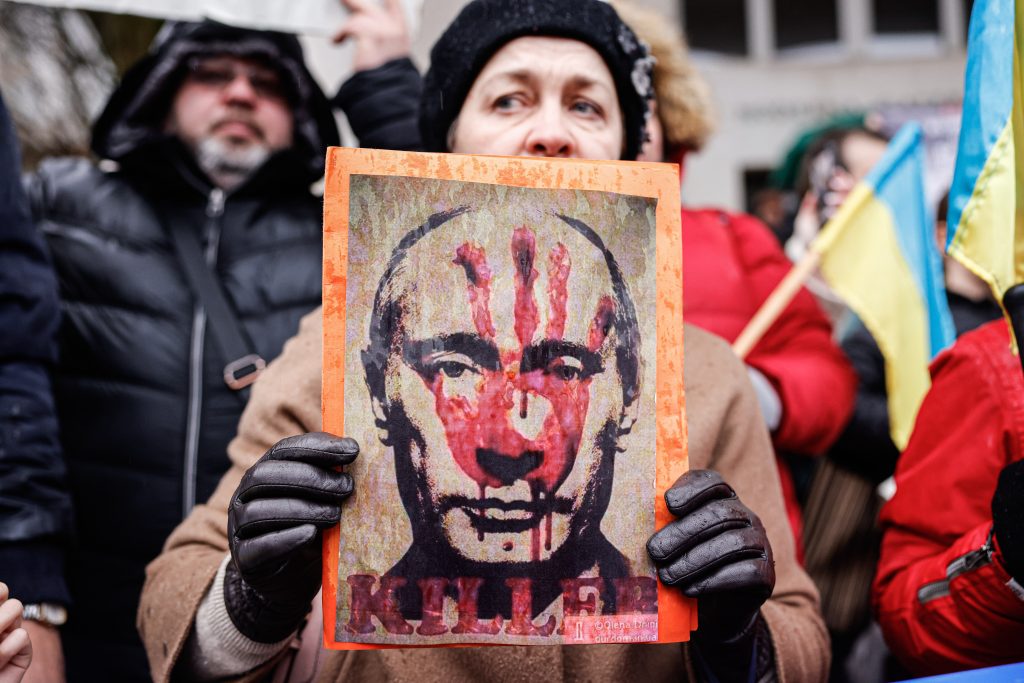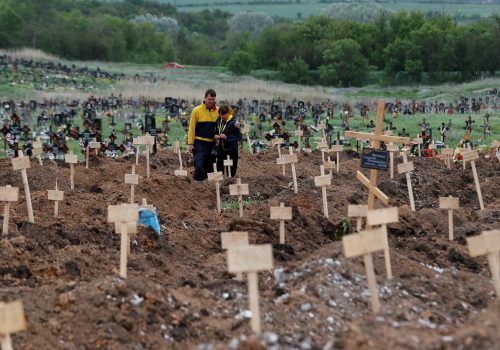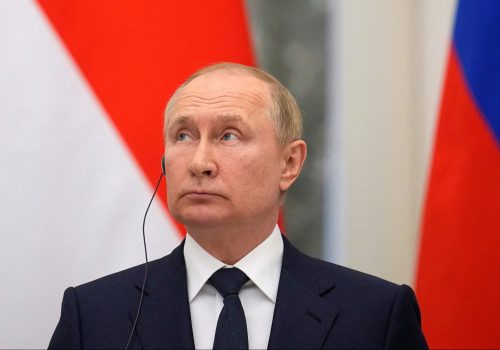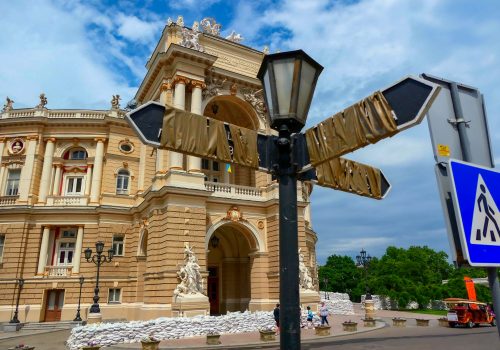Twenty-two years ago, I walked into a hospital and saw an eight-year-old Chechen girl with a horribly burnt face, the only survivor of seven people in a car blown up in a Russian army attack on a refugee column. Just over two decades later in Ukraine, I saw countless cars with the word “Children” scrawled on them similarly shot up by Russian troops. War crimes on repeat.
I wrote my new book “Killer In The Kremlin” in an attempt to somehow make sense of the man behind the snuffing out of so many innocent lives. There is no doubt in my mind that the Moscow apartment bombings of September 1999 were a black flag operation by the Russian security services to make Vladimir Putin, an insipid spy, look strong. Three hundred people died in Moscow and cities in southern Russia. Putin blamed Chechen terrorists and launched the Second Chechen War in which around 80,000 died.
Putin subsequently invaded Georgia and hundreds more lives were lost. He helped Assad in Syria kill around half a million. In 2014, he invaded Crimea and eastern Ukraine leading to 15,000 deaths. The full-scale invasion of Ukraine this February has added to the butcher’s bill: maybe 40,000 Russian soldiers, 15,000 Ukrainian troops and many thousands of Ukrainian civilians have died so far. Leaving aside Syria, the master of the Kremlin is directly responsible for the deaths of some 150,000 people.
Stay updated
As the world watches the Russian invasion of Ukraine unfold, UkraineAlert delivers the best Atlantic Council expert insight and analysis on Ukraine twice a week directly to your inbox.
Widely suspected of having blown up the Moscow apartments in 1999, Putin is also closely linked to at least two more suspected black flag operations, the Moscow Theatre Siege of 2002 where around 170 people were killed, and the Beslan siege of 2004, which claimed 333 lives, many of them children. Common to all three mass killings inside Russia was a total lack of transparency about the investigations into what took place. Numerous journalists and politicians who asked difficult questions were poisoned or shot.
Yuri Shchekochikhin was a Russian MP and journalist investigating these mass killings. He had courage, tremendous energy, a nose for a story and, I’ve been told, a fondness for Armenian brandy. In January 2003, he told a friend, “For the first time in my life I feel frightened.”
In an interview in early 2003 he described Putin’s Russia in a nutshell: “The mafia has put on uniform. The gangsters are boy scouts compared to our security services. Today it is precisely the people who are supposed to be fighting crime who are corrupt. This has not bypassed the secret police. The protection that they provide, the enormous amounts of money that they receive, the control that they exercise.”
Such an independent spirit could not be allowed to exist. In 2003, Shchekochikhin was still asking questions about the Moscow apartment bombings on behalf of a Russian-American woman whose mother had been killed in one of the blasts. But then he started feeling unwell. He went ahead anyway with his trip to Ryazan but grew feverish and felt as though his head was on fire. When he returned to Moscow, he became dizzy and his throat burned. His blood pressure dropped, his skin turned red. The next day his skin began to peel off and his hair started to fall out. He was rushed to the Central Clinical Hospital, known by its nickname “the Kremlinka” because it looks after the power elite and, sometimes, those who cross them. The doctors diagnosed “toxic agents of an unknown origin.”
Shchekochikhin’s girlfriend Alyona Gromova recalled: “On the day he was taken to hospital, he felt very weak. After he had a shower, his hair was a mess. I went to stroke it and great handfuls of hair came out in my hand. The symptoms were confusing. First, it seemed like a cold but his face was very red, as if he had sunburn, then lumps of his skin started to flake off.”
A friend wrote: “Yuri’s condition worsened by the hour. His temperature rose continuously. His mucous membranes were swollen and his kidneys were failing. Then the worst began. His skin began to peel off as though he had suffered severe burns. Even a layman could see what was happening: it was either due to radiation or to some unknown poisons.”
The official verdict was Lyell’s Syndrome or a severe allergic reaction. Shchekochikhin died on June 3, 2003. By then, he had practically no skin left on his body. A friend wrote: “The word poison was never pronounced, although everyone took it for granted. Fear kept people quiet.”
Eurasia Center events

Alyona went to say goodbye to her lover in the morgue. “It was a big place, a huge hall. There were bodies on slabs due to be buried the next day. I looked around. There were about 20 people but I couldn’t find Yuri. I went up to the supervisor and explained that I might be in the wrong place as I couldn’t find him. Through the corner of my eye I saw a dear old lady lying on a slab. The strangest thing, she reminded me of my grandma who passed away a long time ago. The curious resemblance of the two old ladies hit me. In my worst nightmares, I could never, ever have imagined that the dear old lady was in fact Yuri.”
Her lover was so unrecognisable that Alyona could not find him in the morgue until the supervisor pointed out his name tag to her. This was in 2003. The poisonings and the shootings had only just begun. Investigative journalist Anna Politkovskaya? Poisoned, later shot. Human rights activist Natasha Estemirova? Shot. Politician Boris Nemtsov? Shot. Opposition leader Alexey Navalny? Poisoned, now in jail.
Navalny is still alive. Why so? Because Putin fears an uprising if he has him killed. The master of the Kremlin is far weaker than his propaganda suggests. For similar reasons, he dare not call his war a war. The phrase “special military operation” is a signal that he is afraid of telling Russians the truth about the war in Ukraine. The lack of universal conscription shows this fear; the lack of soldiers from Moscow and Saint Petersburg underlines it. I do not believe that Putin would dare press the nuclear button. He is morbidly afraid of his own death. If he tries, I believe the Kremlin’s machinery would not function.
If you study Putin’s career, you realise that we are dealing with a hyper-aggressive psychopath whose word cannot be relied upon. He is a man who identifies compromise as weakness; who sows dissent and mistrust in the West; who likes killing. The idea that we can negotiate with Putin is foolish. Nobody in the West will be safe until he and his killing machine are stopped. Period.
John Sweeney is a British investigative journalist and writer. His new book “Killer In The Kremlin” is published by Transworld Books on July 21.
Further reading
The views expressed in UkraineAlert are solely those of the authors and do not necessarily reflect the views of the Atlantic Council, its staff, or its supporters.

The Eurasia Center’s mission is to enhance transatlantic cooperation in promoting stability, democratic values and prosperity in Eurasia, from Eastern Europe and Turkey in the West to the Caucasus, Russia and Central Asia in the East.
Follow us on social media
and support our work
Image: A protester holds a placard with an image of the Russian president Vladimir Putin during a demonstration against Russia's military invasion on Ukraine. (Photo by Luka Dakskobler / SOPA Images/Sipa USA)




